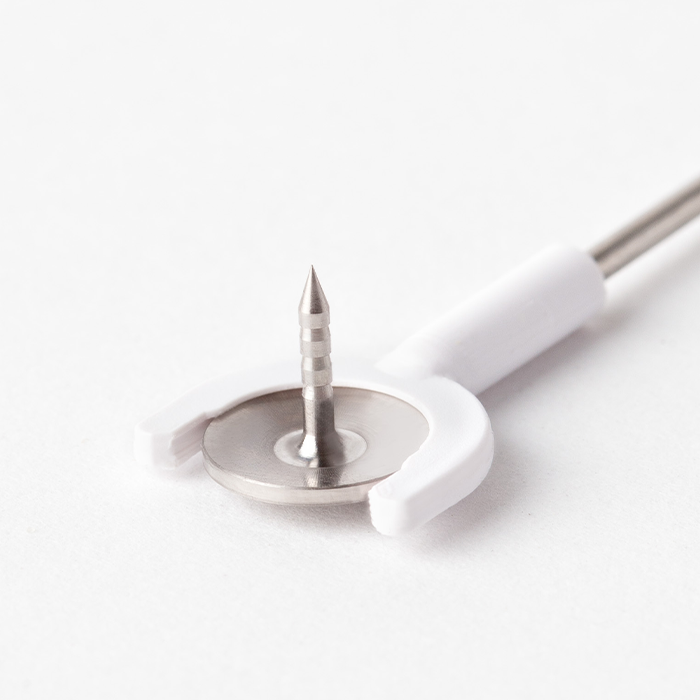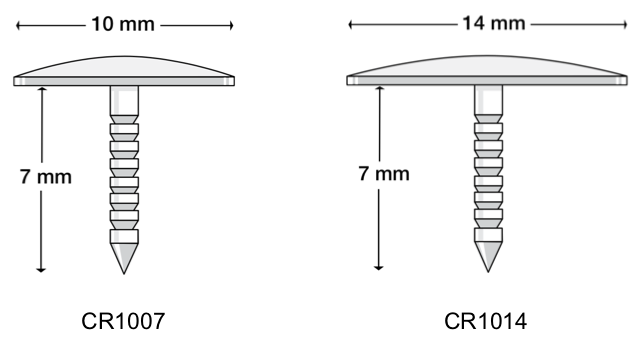Hemorrhage Occluder Pin with Applicator
The Hemorrhage Occluder™ Pin (7mm length shaft) is a simple, well-documented solution to stop presacral bleeding.1 Surgin’s Hemorrhage Occluder Pin was designed in 1993 by Jeffrey W. Milsom, MD at the Cleveland Clinic. It is indicated for the control of localized severe hemorrhage of the presacral area during pelvic surgery.
Ridged Shaft for Secure Placement
The Hemorrhage Occluder Pin is made of titanium, a biocompatible metal commonly used for internal implants.2 The Hemorrhage Occluder Pin shaft (7mm depth) is ridged for more secure placement in the sacrum. Research shows that significantly more force is required to extract a ridged pin than a smooth one.1
Malleable Applicator for Precise Placement
Surgin's Hemorrhage Occluder Pin is pre-loaded in a 12-inch applicator. The handle of the applicator is malleable to provide the surgeon with optimum visibility for precise pin placement at the bleeding site.
Available in Two Sizes (both include a 7mm shaft)
1. Standard: Hemorrhage Occluder Pin with Applicator (Catalog No. CR1007)
2. Large: Hemorrhage Occluder Pin with Applicator (Catalog No. CR1014)
How Supplied
- Each Pin is pre-loaded in its own applicator, individually packaged and STERILE.
- Two Pins are supplied per box.
- Single use only.

Hemorrhage Occluder Pin with Applicator (7mm length shaft)

For pricing and ordering information, please call (714) 832-6300 or email hop@surgin.com.
Catalog Numbers and Descriptions
| Catalog # | Description | Packaged |
|---|---|---|
| CR1007 | Hemorrhage Occluder Pin with Applicator - Standard | 2 Pins/box, Sterile |
| CR1014 | Hemorrhage Occluder Pin with Applicator - Large | 2 Pins/box, Sterile |
| CR2000 | Salgado Driver – Standard | 1/box, Non-sterile |
| CR2005 | Salgado Driver – Large | 1/box, Non-sterile |
All sales are subject to Surgin's Return Policy
Pricing subject to change
Instructions for Use
Description
Indications
The Hemorrhage Occluder Pin is indicated for the control of localized severe hemorrhage from the presacral area during surgery. The pin should be used when other techniques (cautery, suture, clamping, etc.) are judged ineffective.
Contraindications
- Bleeding deemed controllable by direct suture or electrocautery.
- Severe instability of the patient as measured by severe hemorrhage or hypertension.
- Bleeding further than 2 cm from the midline. Bleeding that appears to originate from a sacral neural formina or a vital structure such as a ureter, rectum, or vagina.
- Diffuse hemorrhage related to a systemic coagulation disorder not controllable by fingertip pressure against the anterior surface of the sacrum.
Instructions for use
- When the bleeding is controlled, prepare the preloaded sterile applicator for use by bending the malleable shaft as desired.
- Clear the surgical field of blood and clot, and retract adjacent organs for optimal visibility of the presacral area.
- Rapidly withdraw the hemostatic finger and place the Hemorrhage Occluder Pin directly over the bleeding area. Apply fingertip pressure to the head of the Pin, pushing it into the bone.
- Apply direct and steady pressure until the Pin is fully seated with the head of the Pin flush with the bony cortex. Surgin offers the Salgado Driver to assist in fully seating the Pin in the bony cortex.
- Consider placement of a second Pin if the bleeding continues and appears to be emanating from a second site. Avoid overlapping Pin heads.
Complications
Complications may result from the use of the product. They depend upon the patient's degree of intolerance to any foreign object implanted in the body.
Caution
Reuse of re-sterilization of this device may result in operational failure, injry, and/or risk of infection to the patient.
* A variety of surgical techniques may be used when implanting the Hemorrhage Occluder Pin. Therefore, the surgeon is advised to use the method which his own practice and discretion dictate to be best for the patient.
- Stolfi, V.M., Milsom, J.W., Lavery, I.C. et al. Newly designed occluder pin for presacral hemorrhage. Dis Colon Rectum 35,166–169 (1992). DOI: https://doi.org/10.1007/BF02050673
- Dougherty, S.H., Simmon R.L., Infections in Bionic Man: The Pathobiology of Infections in Prosthetic Devices, Curr. Probl. Surg., 1982: 221-264.DOI: 10.1016/0011-3840(82)90035-1
- Wang Q., Shi W., Zhou W., He Z., New Concepts in Severe Presacral Hemorrhage During Proctectomy, Arch Surg., 1985:1120:1013-1020. DOI: 10.1001/archsurg.1985.01390330025005
- Abrahms, H.L., The Vertebral and Azygos Venous Systems and Some Variations in Systemic Venous Return, Radiology, 1957:69:508-526.DOI: 10.1148/69.4.508
- Baston, O.V., The Role of the Vertebral Vein in Metastatic Process. Ann. Intern. Med., 1942: 16:38-45. DOI: 10.7326/0003-4819-16-1-38
- Krause, U., Pahlman L, Phoren L., Abdominoperineal Excision. World Surg., 1982:6:549-553. DOI: 10.1007/bf01657868
- Nivatvongs, S., Fang D.T., The Use of Thumbtacks to Stop Presacral Hemorrhage, Dis. Col. & Rect., 1986: September, pp 589-90.DOI: 10.1007/bf02554267
- Norgore, M., Clinical Anatomy of the Vertebral Veins, Surgery, 1945:17:606-611. DOI:https://doi.org/10.5555/uri:pii:0039606045901073
- Qinyao, W., Weijin, S., Youren, Z., Zhengrui, H., New Concepts in Severe Presacral Hemorrhage During Protectomy, Arch Surg., 1982:19:1013-1020.DOI: 10.1001/archsurg.1985.01390330025005
- Remarks about Severe Presacral Hemorrhage, Editorial: Pract. Surg., 1981:1:293.
- Welch C.E., Ottinger L.W., Welch J.P. (1980) Cancer of the Rectum and Anus. In: Manual of Lower Gastrointestinal Surgery. Comprehensive Manuals of Surgical Specialties. Springer, New York, NY. DOI: https://doi.org/10.1007/978-1-4612-6012-7_8
